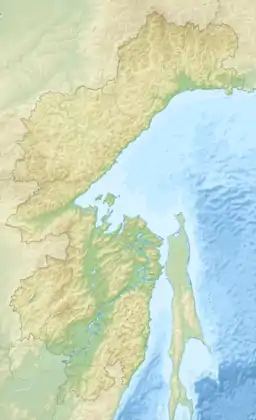Bureya Massif
The Bureya Massif (Russian: Буреинский хребет, Bureinskiy Khrebet)[1] (50°N 133°E) is a mountain range in the Khabarovsk Krai in the southern part of the Russian Far East.
| Bureya Massif | |
|---|---|
| Russian: Буреинский хребет | |
 Bureya Massif in Khabarovsk Krai | |
| Highest point | |
| Peak | Unnamed |
| Elevation | 2,167 m (7,110 ft) |
| Dimensions | |
| Length | 400 km (250 mi) |
| Geography | |
| Country | Russia |
| Region | Khabarovsk Krai |
| Range coordinates | 50°0′0″N 133°0′0″E |
| Geology | |
| Orogeny | Alpine orogeny |
| Type of rock | Granite, gneiss, sedimentary and effusive rocks |
The Dusse-Alin Tunnel on the Baikal Amur Mainline crosses the ridge to enter the Amgun River valley.
Geography
The massif consists of a number of separate ridges with a total length of about 400 km and with a maximum height of 2,167 metres (7,110 ft).[2] The is a northern prolongation of the range. The Bureya Massif forms the drainage divide of the Bureya, Amgun and Urmi rivers. The sources of the Selemdzha River are located where other three ranges meet the massif, the Dusse-Alin from the south, the Ezop Range from the west and the Jam-Alin from the north.
Flora
The slopes of the range are covered by conifer and deciduous forests.[2]
References
- Bureya Massif, Khabarovskiy Kray, Far-Eastern Region, Russia
- Bureya Range // Great Soviet Encyclopedia : (in 30 vols.) / Ch. ed. A.M. Prokhorov . - 3rd ed. - M .: Soviet Encyclopedia, 1969-1978.